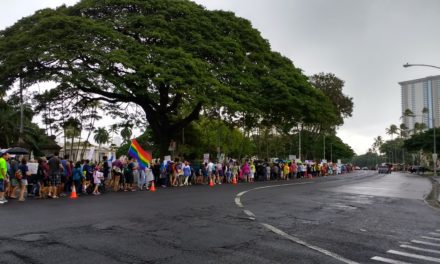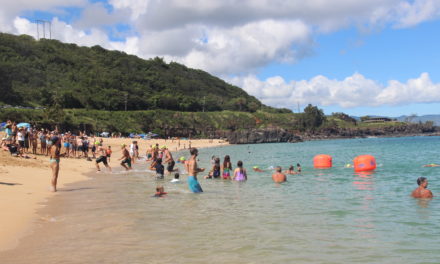Kapiʻolani Community College is named after Queen Kapiʻolani and has adopted her motto, “Kūlia i ka nuʻu,” which means to strive for the highest. (Photo by Cameron Enomoto)
By Cameron Enomoto | Staff Writer
Hawaiian History month was first recognized in 2020 by the Hawaiʻi Ponoʻī Coalition with the purpose of celebrating Queen Liliʻuokalani’s birthday and honoring the proud heritage of the Native Hawaiian people. In Hawaiian culture, it is important to have deep respect and a connection with the place you live. While many Hawaiʻi residents are familiar with sandy beaches and tropical weather, it’s likely that the history aspect of living in the islands is overlooked.
Queen Liliʻuokalani was the last sovereign monarch of Hawaiʻi and rose to the throne after the passing of her brother, King Kalākaua. She was a strong, brave, and knowledgeable leader with the necessary skills to guide a kingdom. This was shown in her determination to strengthen the political power of the Hawaiian monarchy. However, she was met with opposition from the Committee of Safety. With assistance from the American Minister to Hawaiʻi, the Committee of Safety was able to establish a provisional government and overthrow the Hawaiian monarchy.
During the time of the overthrow, Queen Liliʻuokalani did everything in her power to claim Hawaiian sovereignty without putting people in harm’s way. Letters of protest written by the Queen were sent to President Benjamin Harrison and President Grover Cleveland. The treaty of annexation was originally withdrawn by Cleveland and James Blount, a congressman from Georgia, was sent to investigate the newly established provisional government. In December 1893, President Cleveland issued a statement condemning the actions taken by the provisional government and demanded they restore the throne to Liliʻuokalani. However, the government led by Sanford B. Dole deceitfully renamed themselves the Republic of Hawaiʻi and claimed that the right of the United States President to interfere was not recognized in domestic affairs.
The overthrow, annexation, and push into statehood were wrong and were disgusting displays of ignorance and disregard for indigenous peoples. Now, the Native Hawaiian people are suffering from the consequences of those actions. Not only has culture been lost and misrepresented, but life in Hawaiʻi has also become increasingly difficult amidst destructive tourism, high costs of living, and threats to essential resources.
Unfortunately, it’s no surprise that there is a lack of awareness regarding Hawaiian history and culture. Within the educational environment, both in Hawaiʻi and on the mainland, there’s a limited amount of Native Hawaiian representation. Most people remain unaware of the continuous struggle Hawaiians are faced with today due to past events. However, honoring Hawaiian history and sharing the stories of our ancestors provides a way to educate residents and visitors while simultaneously reconnecting our heritage for generations to come.
In 1895, Hawaiian royalists attempted to restore Queen Liliʻuokalani to power, though they were unsuccessful. As a result, she was put on trial in her own throne room. She was later convicted and imprisoned in a bedroom inside ʻIolani Palace for almost 8 months. While she was wrongfully imprisoned, Queen Liliʻuokalani wrote a transcription of her most popular song, “Aloha ʻOe,” along with “The Queen’s Prayer” and “Kuʻu Pua i Paoakalani.”
Prior to Queen Liliʻuokalani’s ascension to the throne, King Kalākaua and Queen Kapiʻolani were in power. Kapiʻolani Community College, named after Julia Napelakapuokakaʻe Kapiʻolani, continues to honor her memory by adopting her motto, “Kūlia i ka nuʻu,” which means to strive for the highest. Queen Kapiʻolani was a woman of “sweet disposition and amiable temper,” as described by Queen Liliʻuokalani. She was loved deeply by the Hawaiian people and made numerous contributions that continue to perpetuate her legacy today.
In July 1884, Queen Kapiʻolani and Liliʻuokalani visited Kalaupapa, Molokaʻi to assist leprosy patients. The remote area on the island housed nearly 8,000 patients over 150 years, making it the largest leper colony in the United States. Sadly, living conditions were poor and patients suffered from loneliness since they were not allowed to leave. Any children conceived in the leper community were separated from their parents and raised elsewhere. Upon observing this happening, Queen Kapiʻolani opened the Kapiʻolani Home for Girls in 1885 with the purpose of serving healthy girls whose parents were suffering from leprosy. The home successfully provided education for girls ages 2-20; in 1898, a similar institution was established for boys of leprous parents.
Queen Kapiʻolani was one of the most well-traveled Hawaiian monarchs and had the opportunity to attend Queen Victoria’s Jubilee celebration. During her trip to London, she visited many hospitals and care homes, inspiring her to bring quality healthcare to Hawaiʻi. In 1890, the Kapiʻolani Maternity Home opened and is known today as the Kapiʻolani Medical Center for Women and Children. Since beginning operation, Queen Kapiʻolani’s vision of helping underprivileged Hawaiian mothers and babies has been realized.
Ultimately, both Queen Liliʻuokalani and Queen Kapiʻolani had an undying love for their kingdom and were dedicated until the end to provide nothing but the best for their people. Recognizing their sacrifices and working to uphold their legacy is only the beginning to creating a Hawaiʻi that they would be proud of. It is important for both native and non-native people to continue advocating for accurate Hawaiian representation and the inclusion of Hawaiian history and culture in classroom curriculums. As Queen Liliʻuokalani said, “…there is still time to save our heritage. You must remember never to cease to act because you fear you may fail.” Let us all lead Hawaiʻi to a greater tomorrow.
In honor of Queen Liliʻuokalani’s birthday and Hawaiian History month, the Hawaiʻi Ponoʻī Coalition is holding in-person and virtual events throughout the rest of the month. To learn more about these events, visit the Hawaiʻi Ponoʻī Coalition website.






